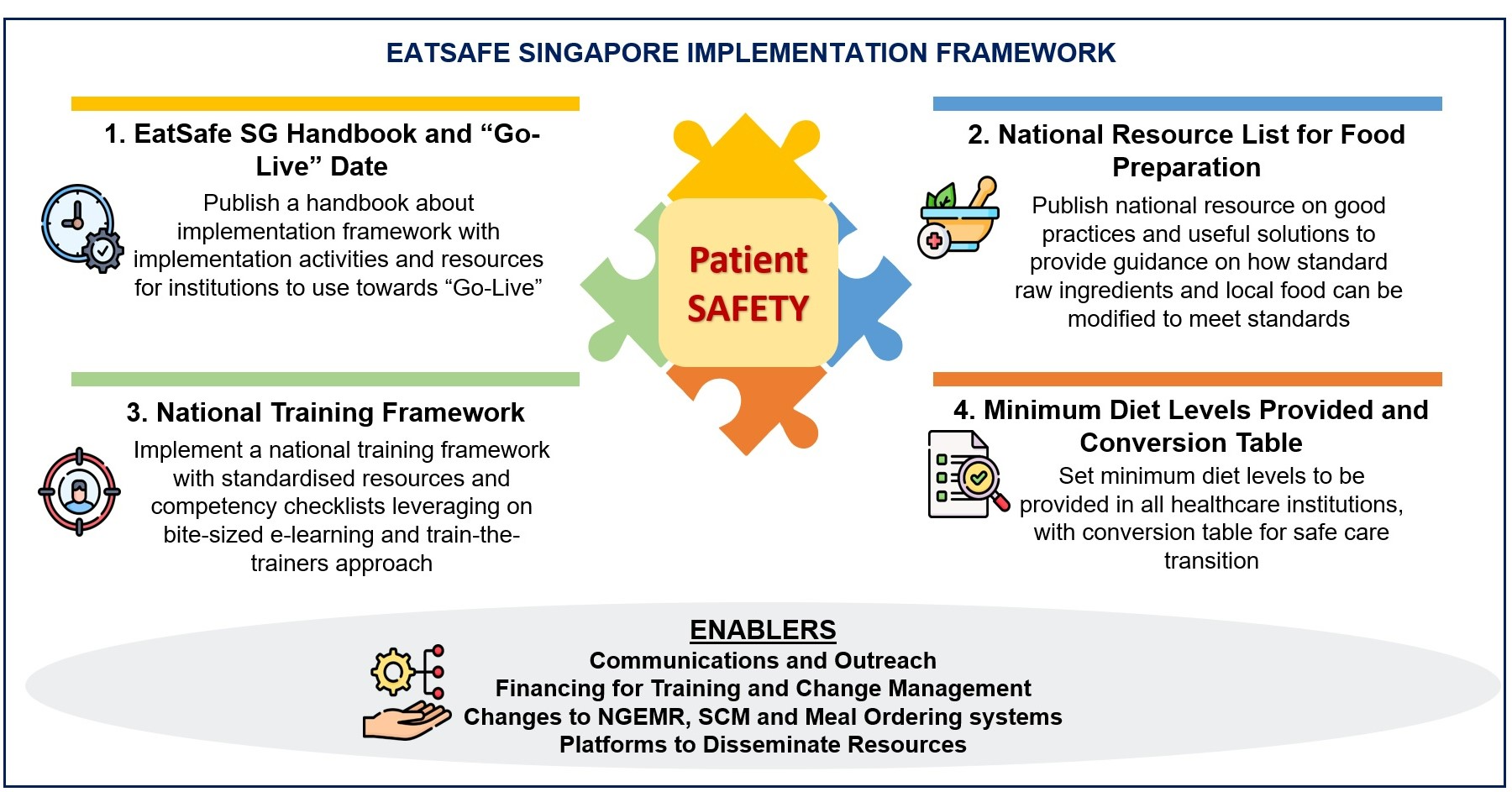1. What is EatSafe SG?EatSafe SG is an initiative that aims to provide a common language for everyone involved in the care of individuals with swallowing difficulties (dysphagia) when communicating about dysphagia diets and modified fluids. Its main objective is to ensure safety for these individuals.
The Ministry of Health (MOH) Singapore Dysphagia Diet Standardisation Committee comprising nursing home leaders, speech therapists, dietitians, administrators, Agency for Integrated Care (AIC) representatives and medical advisor recommended the implementation of the International Dysphagia Diet Standardisation Initiative (IDDSI) framework (www.iddsi.org) across healthcare institutions and community care services in Singapore. The IDDSI Framework is a globally standardised framework of diet and fluid terminologies and descriptors to describe texture modified foods and thickened fluids used for individuals with dysphagia.

2. Why is EatSafe SG important?
Dysphagia can occur due to medical conditions like stroke, degenerative diseases and, in head and neck cancer. It is often associated with malnutrition, dehydration, chest infection and in some cases, even death.
Speech Therapists are healthcare professionals trained to assess and manage dysphagia via one or more of the following approaches:
- Rehabilitation (e.g., exercises to strengthen muscles used for swallowing)
- Strategies (e.g., adapted utensils or specific head/body postures when swallowing)
- Modification of food textures (e.g., pureed diet) and fluid thickness
Modification of diet and fluid is most commonly recommended. Currently, different healthcare institutions in Singapore use different terminologies to refer to texture-modified diet and fluids.
| | Healthcare Institutions - acute hospitals, community hospitals and Intermediate Long-term Care facilities (ILTCs) |
| Dysphagia Diet Terminologies | Diet Types | A | B | C | D | E | F | G | H | I | J |
| Diet Type 1 | Blended (Pureed) | Blended diet | Pureed diet | Puree diet | Finely minced diet | Pureed diet | Pureed diet | Blended texture | Blended diet | Pureed diet |
| Diet Type 2 | Finely minced (Soft and moist) | Minced diet | Minced diet | - | Chopped diet | Porridge and chopped Sides | Minced diet | Soft moist texture | Finely minced (fish, egg, tofu) | Minced diet |
| Diet Type 3 | Chopped (Easy to chew) | Chopped diet | Soft diet | Easy chew | - | - | Soft and chopped diet | Easy chew texture | Finely minced (meat), coarsely minced | Soft diet |
| Diet Type 4 | - | Soft diet | - | - | Soft diet | Soft diet | Regular soft diet | - | Soft DOC | - |
| Diet Type 5 | Regular | DOC | Regular diet | - | DOC | DOC/Full diet | Regular diet | Regular texture | DOC | Regular diet |
Varied terminologies for diets and fluids pose great safety concern especially in the long-term care settings where residents are transferred from different healthcare institutions. This might inadvertently result in wrong diets being served and puts the patient at risk of choking.
The objectives of EatSafe SG are to:
a. improve patient safety;
b. improve communication within and between healthcare professionals, healthcare providers and patients by reducing misunderstandings and ambiguity when communicating diet or fluid related information; and
c. adopt standardised diet and fluid labels and descriptors when conducting and publishing research that is aligned to an international framework.
3. Who is involved?
Implementation of a national standardised diet and fluid terminology framework involves coordinated efforts from multiple stakeholders from numerous settings and institutions. These include nearly 55,000 professionals who are involved in the care of patients with dysphagia, ranging from clinical staff to food preparation personnel.

4. How will it be done?
The Committee has recommended a four-pronged approach in implementing this standardised framework in Singapore.
-
EatSafe SG Handbook and “Go-Live” Date
-
The development of an EatSafe SG Handbook which provides a guide and resource for institutions implementing the IDDSI framework. It contains information such as:
- Implementation Guide and Timeline
- EatSafe SG Resource List for Local Food Preparation
- EatSafe SG Training Framework
- Information about Enablers
-
EatSafe SG Resource List for Food Preparation
- A reference guide for food preparation staff or chefs on how standard raw ingredients and local food can be modified to meet IDDSI levels
- EatSafe SG Training Framework
- The training approach from national to organisational level, and identified training groups and curriculum.
- Basic and Advanced Workshops for Community Care sector will be available in Community Care Learning Management System (CCLMS). For more details, please refer to https://aic-mosaic.sg/2022/12/23/dysphagia-courses-community-care-staff
- Minimum Diet Levels Provided and Conversion Table
- All institutions are to provide minimally 3 Diet levels from the IDDSI framework.
- A diet conversion table to map to the appropriate diet when patients transit to the next care setting if the recommended diet is not available.

Please submit any queries regarding EatSafe SG to EatSafe SG Connect Form
https://go.gov.sg/eatsafesg

Useful resource and links
- How to make “Food Textures Made Easy” (Sengkang General Hospital)
Diet Modification Video Guide (Level 5 Minced and Moist)
Diet Modification Video Guide (Level 6 Soft and Bite Sized)
Diet Modification Video Guide (Level 7 Easy to Chew)